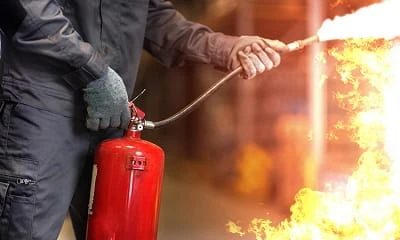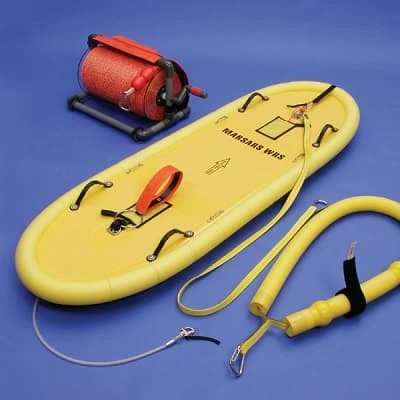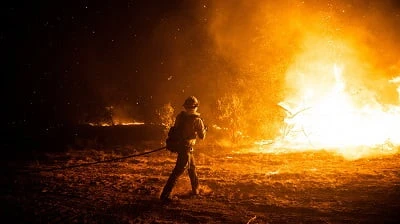by Christopher Jones
We all have some form of smoke detection in our homes. Whether it is the standard ionization smoke alarms, or the more accurate dual differentiation alarms like those developed by Crossfire, smoke alarms give us a sense of security in the event of a fire. However, if a fire does occur, these alarms do nothing to actually extinguish the flames. That’s why more and more people are putting a fire sprinkler system into their home.
Automatic fire sprinklers react similar to a smoke detector, by going off once their detection system sense smoke or a rise in heat. Fire sprinkler systems can often react quickly enough to control and even completely extinguish flames before the fire department arrives. While we see these systems in office buildings, hotels and other public establishments, few of us consider them for our own homes.
Contents
In the United States, roughly 85% of all fire-related deaths occur in the home. According to an American Housing Survey, only about 4.6% of residential buildings had sprinklers in 2009, most of those in newer builds. One of the largest reasons people don’t think of putting fire sprinklers in their homes is that they don’t realize it is an option. However, more and more people are seeing the life-saving impact these systems can make.

The most important step to take towards fire safety during a drought is to avoid creating a fire of any kind. Do not burn any trash, debris, leaves or other materials outdoors, and exercise extreme caution when grilling. If there is a lot of leaves, dry brush or other materials around your home, try to move them as far away as possible to create a “safe zone” around your house.
If you store firewood at your home, make sure it is put away safely. Keep it at least 15 feet from your home and preferably somewhere uphill. Maintain your lawn and land around the home by eliminating any dry or flammable materials. Regular raking and leaf-removal can make a huge impact on your safety. If you do plant new plants, look for fire-resistant species that will be less likely to cause a blaze.
Avoid parking vehicles on grass, as the oils and heat can cause the dry grass to catch fire. If you have flammable materials such as gas, oil or paints, make sure they are stored in a cool place at least 30 feet from your home.
Make sure you educate your children on what a drought means and how it affects them. Teach them fire safety and how to keep themselves and others safe when at a higher risk for fire.
Droughts are a dangerous time for many reasons, and fires are one of the many things that can result from the hot, dry air. Do what you can to prevent a fire and keep your home safe, and you can help make it easier for your community to survive a drought.

It’s getting chilly out there, which means it’s time to brush up on our ice and cold water safety. Cold water is any water that is below 70 degrees Fahrenheit. This may not seem that bad, but cold water can rob the body of heat 25 to 30 times more quickly than air. This escape of body heat can lead to hypothermia and death.
It is important to understand the symptoms of hypothermia so you can recognize it quickly. The most obvious symptoms are confusion, lack of coordination, slurred speech, uncontrollable shivering, and unconsciousness. If you recognize these symptoms in yourself or others there are steps to take to help someone with hypothermia.
First, always call for medical help immediately. Then, if the situation is safe for yourself, remove the victim from the cold water or air. Once they are out of the cold area, remove any wet clothing and keep them as dry as possible. It is very important to keep the victim as warm as possible. So, wrap them up in blankets and build a fire to raise their temperature. Giving them warm liquids to drink will warm their internal temperature, just make sure it includes no alcohol or caffeine. Finally you can place the victim in a warm bath with their arms and legs out of the water, this helps their core temperature rise first.
Hopefully, no one finds themselves in a situation where the above tips for helping with hypothermia victims is necessary. To help prevent that situation from happening the following are useful tips for preventing hypothermia before it starts. Always wear layers of warm clothing in cold environments. It is especially useful to cover your hands and head with hats and gloves. Everyone should keep as dry as possible. When near cold water make sure to always wear a personal floatation device. To make sure you can always start a fire, carry matches in a waterproof container.
If you plan to walk out onto ice remember that there is no surefire way to recognize if ice is safe. There are many factors to recognizing ice safety; including thickness, temperature, age, depth of water under the ice, etc. All of these things factor into whether ice is safe or not and none of them create a situation that is 100 percent safe. Another factor to remember is that ice on moving water is never safe.
Reach-Throw-Go. These are the three words someone should remember if a companion falls through ice. The first step is to simply reach for the victim and try to pull them out. If you are unable to reach the person from shore the first step is to throw them something they can grab onto. This can include a rope, jumper cables, tree branch, etc. As a last resort, go find help before you also fall through the ice. Immediately after the victim is safe and out of the ice call for medical assistance.
If you yourself fall through the ice the first step is to not panic. Next you will want to go towards the direction you came from and place your arms on the unbroken surface of ice. Using your feet kick yourself out of the water and remain lying flat on the ice. Roll away, never stand back on the ice, and crawl until you return to solid ice or ground.
These tips will help you and the people you are with during this holiday season be safe and have fun in the outdoors. Still, perhaps the best advice one could have for outdoor safety is to always be mindful of your surroundings and respect the environment around you.

As a kid, we all saw people, generally the elderly, who used oxygen tanks and machines to assist them in breathing. When it comes time for a family member to use oxygen therapy, many of us don’t think of fire safety as an issue. However, oxygen is one of the key elements in fire, and therefore poses a risk anytime compressed oxygen is present. When grandma finds out she needs to depend on an oxygen machine, her first thought isn’t on safety but yours should be.
Home oxygen machines are relatively small in size, most take up less than three square feet. To set up the oxygen machine, you plug it in. Most allow you to adjust the amount of oxygen running through them, based on the doctor’s recommendations for the person using the machine. Most work by taking in air from the outside, compressing it, removing the nitrogen and other gases, then emitting pure oxygen through the breathing tubes. Some use water to assist in the process.
When setting up an oxygen machine in the home, make sure it is kept at least 5 feet from gas stoves, lighted fireplaces, woodstoves, candles, or any other sources of open flames, according to WebMD. When using oxygen, avoid using oil, grease or other flammable liquids, such as anything petroleum-based. Highly flammable materials can easily ignite in the presence of oxygen, so when in use stay away from things like this.
Oxygen tubes can dry out nasal passages, which means grandpa might need a moisturizer. When selecting moisturizers avoid things that are petroleum-based like Vaseline. Look at ingredient in moisturizers and go for ones like cocoa butter, aloe vera, or other similar, less flammable products. Water-based products are ideal to moisturize nasal passages.
Once we reach a certain age, we become a bit more stubborn, which is why grandma refuses to quit smoking. It might require you to baby-sit, put up signs, or even hide the cigarettes and lighters, but NEVER let anyone smoke while wearing oxygen or near oxygen. If grandma must smoke, which is often the case, make sure she always takes her oxygen off before going outside to light one up.
When securing your oxygen tank, make sure it is solid and secure. Since it is compressed air, it has the potential to explode or even launch like a missile. Make yourself completely familiar with the equipment so you can ensure it is safe and functional. Talk with the manufacturer and have their number somewhere you can easily find in case you have any questions. Before the oxygen is installed, test your smoke and heat detectors to ensure they work. Since oxygen machines are loud, they are often placed in rooms we don’t use as often. If this is the case, you may want to consider upgrading your fire protection to an inter-connected system like Crossfire Alarms, so you know if that room has become a hazard.
Oxygen therapy is a great way to help those with breathing issues continue life on their terms. If someone in your home needs oxygen, make sure everyone in the home knows the safety issues that come with the machine, and know how important it is to handle oxygen safely.

Senior citizens are almost twice as likely to be killed in the event of a fire than their younger counterparts. Making up at least 12% of the population, people aged 65 and older are growing in number and with that their risks of injury and endangerment grows. When it comes to fire safety, we need to take extra precautions to keep elders safe. Keep these tips in mind for when you inevitably reach the age where you are labeled as “senior.”
According to the National Fire Protection Association, one of the best things to do to keep seniors safe is for their bedroom to be on the ground floor. It is no secret that the older we get, the more trouble we have moving, especially up and down stairs. So if possible, try to get grandma a room on the first floor. Make sure granny’s room has a smoke alarm in her room and she is able to hear (or see) it in the event that it goes off. If you’re looking for an apartment or retirement home for grandpa, make sure it has an automatic sprinkler system in place. These can help put a fire out before the fire department is even needed.
As we age, our hearing deteriorates. This means that if it is late at night, your grandparent might not hear the alarm warning them of a fire. Crossfire Alarms has designed alarms that not only work to go off in every room of the home, but also are extremely loud. We designed our alarms to be heard by neighbors, so even if grandma can’t hear, someone will be able to hear in time to help her get to safety. In addition, some alarms, like Crossfire, light up in the event of a fire. This ensures that people can always be aware of a fire in time.
Whenever grandpa moves into his new place, even if it is at your home or an elderly home where they have a fire escape plan in place, go over and practice your fire escape plan. Have your grandparent go over the safety precautions in their home, and know the best route to get out and to safety. Help your grandparent or parent out by writing out or drawing what their personal escape plan is, so they know what to do in an emergency.
Make sure any home occupied by an elderly person is easy to navigate. Make sure doors are easy to open completely, and are not regularly blocked by anything that could cause your grandparent to fall, get injured, or make it harder for them to escape. Make sure all windows are easy to open and can be opened quickly if that is the best route for escape.
Our parents and grandparents need some extra help as they age. While they might not like all the extra precautions we take, it can make all the difference to make the effort to keep them safe if a fire occurs.
Whether it is a large corporate event, an intimate gathering, or a wedding, when planning an event you want to do as much as you can to ensure everything goes off without a hitch. From planning the itinerary to confirming the caterers, there’s a lot of planning that goes into a successful occasion. One of the most important things to do is to plan for fire safety.
The food
More often than not, food at events is heated using sterno candle. These gel warmers come in tin canisters and sit under the serving trays to evenly heat the food. If gel fuel food warmers are in use, make sure a type ABC fire extinguisher is on hand for emergencies. Do not put sternos out with water, and instead smother them using a fireproof plate or their own lid. Do not place any combustible materials near the gel fuels, and make sure no one tries to touch or mess with the sternos while they are lit. Never use one candle to light another, never carry lit cans, and always make sure the can is cool before you handle it.
The decorations
Make sure any decorations, equipment and wall coverings you use are flame-resistant. Do not let any decorations obstruct a fire exit, or be placed in a spot that could result in injury or fire. If you are using sound equipment make sure the person setting up and utilizing equipment is trained and able to do so without causing harm or potential hazard. Avoid using any open flame candles for decoration. If you really want to set the tone with mood lighting, look for battery-operated candles so you don’t have to worry about watching irresponsible guests.
The furniture
If seating is provided for the event, make sure it is safely set up. Do not allow tables to be too close, as this could become a hazard if a fire occurs. Make sure there are clear aisles and walkways for people to safely maneuver through. Even if there isn’t a fire, people don’t want to have to step over one another to get around. Make sure furniture is arranged to not only look good, but also provide for people to safely and easily walk and dance around.
The celebration
If the space you are in has a maximum capacity, make sure you don’t exceed this. Those are in place for a reason and help keep you safe. Have someone on hand to monitor all exits, halls and stairways for potential hazards. Have an evacuation plan in place in case of an emergency, and if an emergency occurs do your best to guide people to the safest exit route. If there will be dancing, make sure any hazards are off the dance floor and give at least a 3 foot perimeter to prevent any potential injuries.
If you plane properly, there is no doubt that your events can be a success. Once you do your part to ensure everyone’s safety, it is time to celebrate and enjoy yourself.

Winter is almost gone and warm weather is on its way to brighten our days and bring all our plants back to life. No that the winter freezes are over, it’s time to get back outside and bring your yard back to it’s colorful, springtime glory. Before your start up the lawnmower and pile up the leaves, make sure you’re ready to avoid being injured, maimed or worse while working in the yard.
Don’t cut your arm off.
Chainsaws, lawn mowers, and weed whackers are useful and make tedious outdoor tasks go by much faster. However, if you don’t know how to properly use these tools, it could result in serious harm to yourself or your property. Each year, approximately 36,000 people go to the hospital with chainsaw related injuries. To avoid becoming a statistic, make sure you know how to safely use a chainsaw or other dangerous tools, and do not allow anyone to use your tools unless they too know how to do so safely.
Dispose of debris properly.
Dead leaves, fallen twigs, and other debris can be very dangerous if you don’t take care of them. If left on their own, these can pile up and put your home at risk of a fire if any of them should ignite. When you are cleaning up your yard, make sure all debris is gathered in lawn bags, or bundled together and placed by the street, far away from your home. Do not just push leaves and sticks to a pile and ho[e they will disappear, because they won’t. By taking action to get rid of the yard trash, you keep your house looking nice and safe form a potential fire.
Don’t forget the gloves.
Yard work can be messy. Using proper gloves can keep your hands safe from potential thorns or other sharp objects. In addition, it will put a barrier between your skin and any harmful chemicals that could be waiting in the brush.
Check your equipment
Nothing can be more dangerous than an improperly working lawnmower. Before your fire it up, make sure your lawn mower or other gas-powered equipment is functioning properly. Consult your owner’s manual if there is anything that concerns you. If you notice an issue while the equipment is in use, turn it off immediately, get a safe distance away, and call the manufacturer (or 911 if it suddenly catches fire).
Be smart
If there is a jam in your lawnmower, don’t use your hand to try to clear it. Don’t start any equipment indoors. Always have closed toed shoes when using an power tools, and use protective goggles when possible. If using gas, be careful while pouring it into the equipment and make sure you do not overfill or use the wrong kind of fuel.

What’s one thing all ghouls, mummies, goblins, vampires, monsters and witches have in common? They are all flammable. Yes, on even Halloween fire safety is an important part of planning your costumes and celebrations. From a simple Jack-O-Lantern mishap to a flaming costume malfunction, there are a lot of fire hazards present during Halloween.
Beware of Attacking Costumes!
To make sure you and your children aren’t victims of attacking clothing, take a few simple precautions. Avoid costumes with long tails, trails or billowing fabrics, as these can ignite if they sweep too close to a heat source. Whether buying or making costumes, look for fabrics that are flame resistant or flame retardant. And always ensure eyeholes in masks or hoods are big enough for your child to see out of in all directions.
Be Afraid of the Dark!
Trick-or-Treating is one of the best parts of Halloween, no matter what age you are. However, since it involves hundreds of kids walking around at night, you need to be extra cautious. Make sure every child is equipped with a flashlight or glow sticks. You can even dress each kid in glow sticks as part of their costume! This ensures you and everyone else can see your kids.
Decorations of Doom!
Before you turn your home into the ultimate haunted house, you need to find the right decorations that bring the right amount of horror without causing any real horrors. If you plan to use paper, plastic or other disposable decorations, make sure you don’t place them near any kind of heat source including light bulbs. Many decorations are highly flammable, so read all precautions before hanging them up. Use flameless candles instead of real candles to give your home some spooky lighting. And even though it might seem cool to turn your entry way into a doorway to the dark world, make sure none of your decorations are blocking the escape.
Jack-O-Lantern Scares!
Carving pumpkins is a classic Halloween tradition. However, it can also be a dangerous endeavor. Before carving the scariest face you can imagine, make sure no children under the age of 10 handle sharp objects. Instead allow children to draw their design for you to carve (but feel free to let them play with the pumpkin guts). When bringing your Jack-O-Lantern to life, opt for flameless candles or glow sticks to avoid your pumpkin getting obliterated by fire.
Warn Your Little Monsters!
Your children can be anything they want for Halloween, as long as you make sure one thing they are is safe. Talk with your kids about safety while walking to and from houses, when approaching homes, and how to avoid fire or other Halloween hazards. The more you talk with your kids and prepare them, the more likely you will all have a Happy Halloween!

We’ve all been there. You’re on your way to work and suddenly hit some traffic. As you get closer you see dark smoke billowing ahead and here the faint sound of sirens. Soon enough you see it; a crashed car completely engulfed in flames.
According to the NFPA, vehicle fires are responsible for roughly 10% of all reported fires in the United States. Between 2006 and 2010, there was an average of 17 automobile fires every hour, accumulating to an average of four fatalities per week. With the causes ranging from mechanical and electrical failures, to collisions and fuel fires, there are many reasons a car could catch fire. In the report published by the NFPA, an average of 152,300 automobile fires occurred per year causing an annual average of 209 civilian deaths and 764 injuries.ith how often car fires occur, it’s never a bad idea to be prepared to escape safely in case it ever happens to you. When it comes to surviving a car fire, there are only 5 simple steps:
Step 1: Pull Over As Quickly As Possible
Once you first see flames or smoke or smell burning rubber and plastic, you need to act quickly. Immediately turn on your hazard lights and make your way to the side of the road quickly and safely.
Step 2: Turn Off The Engine
Once you are safely to the side of the road, shut your car off immediately. This will cut off the gas source and make it less likely for your car to go up in flames.
Step 3: Get Out
After you turn off the car, get everyone out of the car fast. If you are able to grab belongings, do so quickly, but do not return to a burning car for any reason. If you have children, make sure you help them get out safely and instruct them to listen to you carefully.
Step 4: Step Away From The Vehicle
Move everyone at least 100 feet from the car. Make sure the direction you move is away from traffic. If you are on a freeway, move along the median, giving yourself and your family as much distance between you and any cars.
Step 5: Call 9-1-1
Once you know everyone is safe, call 9-1-1. Even if the car is not on fire yet, it could go up at any moment and you want to have emergency crews there as quickly as possible.
There are a few signs that signal a potential car fire hazard such as faulty wiring, electrical problems, blown fuses, oil or fluid leaks, and rapid changes in fuel level or engine temperature. When in a car, always do your best to take safety precautions to avoid accidents that could result in a vehicle fire. Regular car maintenance can help you prevent a fire from occurring and ensure you are doing your best to keep everyone safe on the road.

 |
 |
 |
 |
 |
 |
 |
 |

About Christopher Jones
Chris is a true globetrotter. He has been to many destinations and tried different types of food from all over the world, yet he still loves finding new places and tasting their specialties. Chris has always had an entrepreneurial spirit and so he decided to go back to school at age 24 for his MBA at University of San Francisco so that he could have a better understanding of business strategy in order to start his own company. His favorite motto is “how can one live well, travel well, and work well without having good food every time?”
Kitchen Goodness
Check for FREE Gifts. Or get our Free Cookbooks right now.
Disable the Ad Block to reveal all the recipes. Once done that, click on any button below
 |
 |
 |
 |